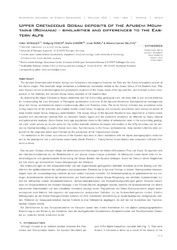Upper Cretaceous Gosau deposits of the Apuseni Mountains (Romania) - similarities and differences to the Eastern Alps
Zeitschrift: Austrian Journal of Earth Sciences [untranslated], 2009, 102: 133 - 145
Dunkl, István; Schuller, Volker; Frisch, Wolfgang; DANIŠÍK, Martin; Melinte, Mihaela Carmen, 2009: Upper Cretaceous Gosau deposits of the Apuseni Mountains (Romania) - similarities and differences to the Eastern Alps. In: Austrian Journal of Earth Sciences [untranslated], 102: 133 - 145, DOI: 10.23689/fidgeo-2725.
 |
Dokument öffnen: |
The Apuseni Mountains were formed during Late Cretaceous convergence between the Tisia and the Dacia microplates as part of
the Alpine orogen. The mountain range comprises a sedimentary succession similar to the Gosau Group of the Eastern Alps. This
work focuses on the sedimentological and geodynamic evolution of the Gosau basin of the Apuseni Mts. and attempts a direct comparison
to the relatively well studied Gosau Group deposits of the Eastern Alps.
By analyzing the Upper Cretaceous Gosau sediments and the surrounding geological units, we were able to add critical evidence
for reconstructing the Late Mesozoic to Paleogene geodynamic evolution of the Apuseni Mountains. Nannoplankton investigations
show that Gosau sedimentation started diachronously after Late Turonian times. The burial history indicates low subsidence rates
during deposition of the terrestrial and shallow marine Lower Gosau Subgroup and increased subsidence rates during the period of
deep marine Upper Gosau Subgroup sedimentation. The Gosau Group of the Apuseni Mountains was deposited in a forearc basin
supplied with sedimentary material from an obducted forearc region and the crystalline hinterland, as reflected by heavy mineral
and paleocurrent analysis. Zircon fission track age populations show no fluctuation of exhumation rates in the surrounding geological
units, which served as source areas for the detrital material, whereas increased exhumation at the K/Pg boundary can be proven
by thermal modeling on apatite fission track data. Synchronously to the Gosau sedimentation, deep marine turbidites were deposited
in the deep-sea trench basin formed by the subduction of the Transylvanian Ocean.
The similarities to the Gosau occurrences of the Eastern Alps lead to direct correlation with the Alpine paleogeographic evolution
and to the assumption that a continuous ocean basin (South Penninic - Transylvanian Ocean Basin) was consumed until Late Cretaceous
times.
Statistik:
ZugriffsstatistikSammlung:
- Geologie [931]

